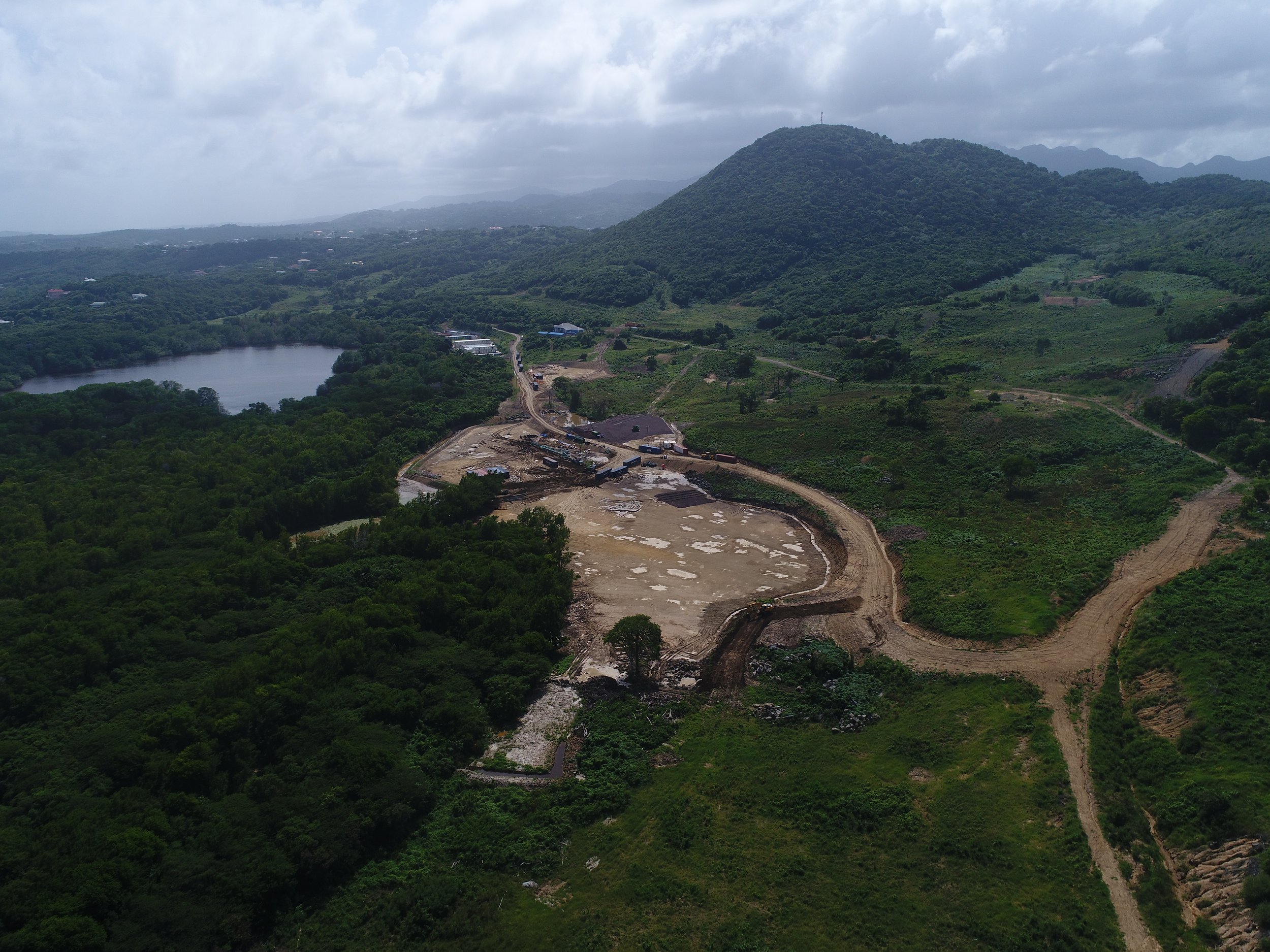While Professing Climate Action at COP 28, Grenada Faces Criticism for the Destruction of Its Sole Ramsar-Protected Wetland in Levera
Aerial photograph showing the ongoing destruction at the Levera Ramsar site - November 2023.
As Grenadians and citizens of Caribbean countries watch the proceedings of COP 28, the world climate change conference where leaders are attempting to tackle the global climate crisis, there is a growing loss of confidence among its people. This skepticism has arisen in response to how leaders are perceived to be handling issues at the local level in their countries. Globally, leaders are struggling to make commitments to limit global warming to below 1.5 degrees, a goal that is fast disappearing due to inaction, with serious repercussions for many countries, especially small island developing states. Meanwhile, Caribbean leaders are struggling to uphold their own existing environmental commitments and to effectively manage the natural resources of their island nations in a sustainable manner.
One of those commitments is the Ramsar convention on the protection of wetlands. Many Caribbean countries have signed onto this convention – one aimed at protecting wetland areas of international importance, since they are important habitats for birds and other species. Grenada signed onto the convention in 2012, under the then NDC government led by Tillman Thomas. Soon after, the Levera wetland, encompassing the pond, mangroves and other vegetation as well as the beach and off-shore island, was designated as Grenada’s first Ramsar site (https://www.ramsar.org/news/grenada-joins-ramsars-162nd-contracting-party). This was a significant environmental win for Grenada and the region at the time.
The Levera area was previously carded to be designated as a National Park, given its importance as third-largest nesting beach for Leatherback turtles in the region; sadly, no national legislation was ever passed to grant it that additional protection, despite signage appearing to proclaim otherwise. The area was also proposed as a Marine Protected Area, but no progress has been made on that front either, despite a recent management plan being drafted. Unfortunately, sites of great natural beauty and diversity such as Levera are often the targets of foreign developers and Levera has weathered many development attempts over the years, some of which have related to fraudulent developers who have left considerable environmental damage in their wake.
Rendering of final approved hotel designs, showing multi-storey buildings and golf courses which run right down to the beach.
This latest development attempt, spearheaded by the developer ‘Singapore Heng Sheng Grenada Development PTE. Ltd’ is the biggest and most outlandish of them all - a billion-dollar development that encompasses an 18-hole golf course, casino, jetty/marina and massive multi-storey, high-rise hotel resort buildings. Fuelled by Grenada’s Citizenship by Investment program, and what appears to be a massive investment by the Chinese government, including a state contractor, this attempt does not appear to be running out of funds any time soon. It also appears that the Government of Grenada is doing everything it can to capitulate to the developers – as it has allowed the boundaries of the Levera Ramsar site, established in 2012, to be modified in the developer’s favour, without any public consultation.
Recent Court disclosures in the case of the local NGO, Grenada Land Actors Inc. (GLA), against the Planning and Development Authority (Physical Planning) confirm that the Government of Grenada signed a confidential Memorandum of Understanding (MoU) with the developer that cuts the boundaries of the Ramsar site, as the public know it, in half. This means that half of the Levera beach, and the immediate nearshore areas adjoining this section of the beach, are now excluded from the original Ramsar designation, leaving most of the nesting Leatherback turtles at risk. Additionally, a buffer of only 10m between the wetland and the development has been approved, further compromising the integrity of a large proportion of the Levera wetland.
A buffer of 100 metres, from both the beach and the wetland, which was also recommended in previous EIAs for the area, would be the minimum zoning necessary to potentially mitigate impacts on wildlife and water quality. However, even this could prove inadequate, considering the substantial loss of vegetation required to accommodate the 18-hole golf course, including in the mountainous terrain surrounding the area.
This MoU was done in secret by the NNP Government and signed by the then Permanent Secretary of the Ministry of Agriculture, Mr. Elvis Morain. None of this is in line with the Ramsar convention agreement and its requirements for local consultation and its focus on upholding wetland integrity.
New boundary for the Ramsar site in Levera, which now excludes much of the beach and only has a 10-m wetland buffer from the development.
GLA wrote directly to the Ramsar Secretariat about these changes on 26th February 2023, but the Secretariat has not responded to date. One also wonders if this secret MoU is in keeping with Grenada’s own Constitution as well as the recently signed Escazú agreement, which calls for access to information, public participation, and justice in environmental matters.
Even worse, the developer, Singapore Heng Sheng Grenada Development PTE. Ltd, appears to have no intention of even honouring the inadequate 10m buffer zones in the MoU. Reports from residents who recently visited Levera suggest that golf course poles are being located directly on the beach, and this aligns with the final golf course plan approved by the PDA (see attached). Two of the final golf course holes, likely 17 & 18, appear to be located directly on Levera Beach, in an area that was previously protected under the original Ramsar designation. The original designs for the golf course do not show the golf course being built in this location so it is surprising that the final designs allowing this (supposedly done by a US based firm - Robert Trent Jones II) have been approved. As GLA recently confirmed through the same Court disclosure, no EIA was completed for the golf course. This is a massive environmental management and planning failure.
Officially approved plan for the 18-hole golf course at Levera, note that holes 17 and 18 encroach onto the beach. Significant coastal vegetation will need to be cut down to accommodate that with significant long-term impacts to turtle nesting.
The new NDC Government has done nothing to stop, control, or even curtail, this development. Documents disclosed show that the PDA, under the new NDC Government, has now given final approval and permission to this preposterous development. GLA reviewed the main environmental impact assessment (EIA) for this development earlier this year (https://grenadaland.org/newsroom/grenada-land-actors-review-of-levera-national-resort-eia) and found it to be a wholly inadequate and flawed document, not befitting of a billion-dollar development, with all the associated impacts.
Probable marker for golf course, currently located on the Levera beach - November 2023
The planning documents show that the developer also intends to build a jetty and marina adjacent to the western edge of the Levera beach. This could be another reason why international protection afforded by the Ramsar convention was removed from this section of the beach and marine areas. The sub-EIA for this jetty was as insufficient as the larger EIA for the hotel development and provides no data as to how this construction will impact the nearshore marine ecosystems in this area, including the Levera beach itself. The accompanying theoretical feasibility studies and plans also suggest that the developer intends to build a breakwater at this location which will require blasting of the coral reefs in this area! This will certainly lead to long-term destruction of the western edge of the Levera beach. Lessons should be learnt from the fallout caused by the unplanned breakwater at nearby Sauteurs.
Plan highlighting the location of the jetty and breakwater at Levera.
Western area of the beach that will likely be sacrificed by constructing a jetty/marina and breakwater as part of the development.
There is no oversight of this massive development and PDA, under the NDC Government, appears to be a revolving door – the CEO has changed at least three times. No stringent conditions have been placed on the developer and numerous outstanding issues remain, including the need to conduct a new EIA for the desalination plant. Yet, the development is speeding ahead, under the final approvals given by the current PDA. If leaders are content to destroy their own natural environment, then what are they advocating for on the global stage at COP? Loss and Damage? What would we call what is happening now, under their watch and by their hand? Grenadian citizens should demand more of their leaders. They should reach out to the current Minister for Infrastructure and Physical Development, the Honourable Dickon Mitchell, current Prime Minister of Grenada, to address the ongoing environmental breaches and concerns associated with this and other coastal developments around the island. One pressing remedy which GLA has been advocating for in the court case, is that regulations be passed under the Physical Planning and Development Control Act 2016, to strengthen the EIA process, which currently appears to be a free-for-all.
Greater international scrutiny and transparency are needed to ascertain how countries are using climate change money, such as from the Green Climate Fund, as well as funds connected with the Convention on Biological Diversity, especially if these countries have little to no capacity for environmental management and in fact are continuing to destroy their own natural resources at present. There needs to be much greater oversight of the existing legislation, human capacity, and enforcement capabilities in small island states such as Grenada, as well as the frameworks in place for the public to be meaningfully involved through public participation and access to information and justice.
This update only touches on one aspect of the legal challenge that GLA is bringing against the PDA. Two other important sites, which are also part of the legal case, are being destroyed in Grenada - La Sagesse and Mt. Hartman. Many of the aspects remain the same, funded by CBI programs, inadequate EIAs and poor planning. Stay tuned for part two…







